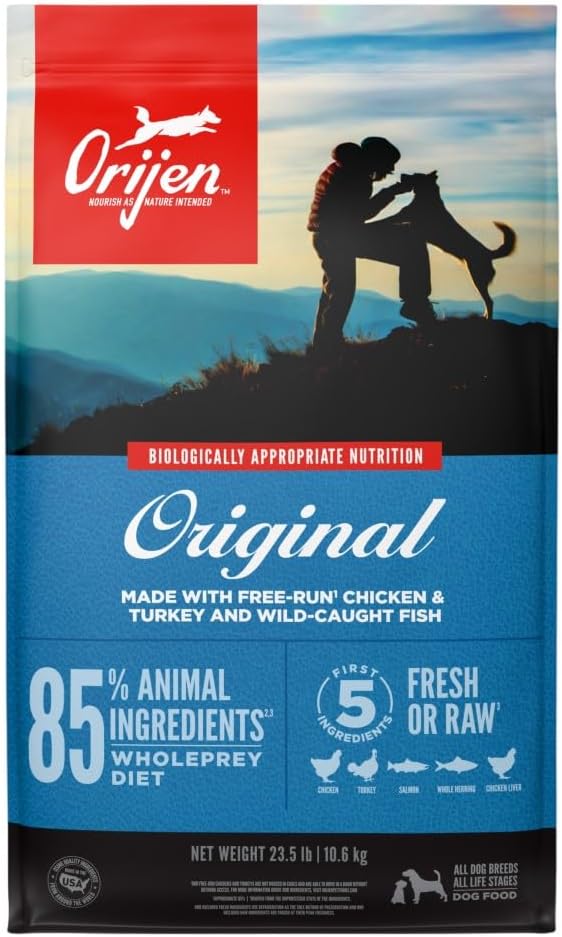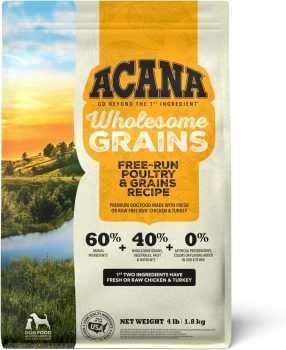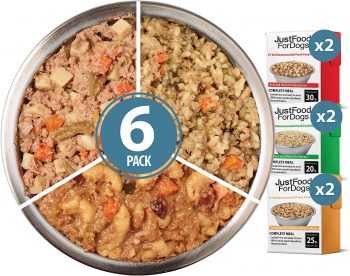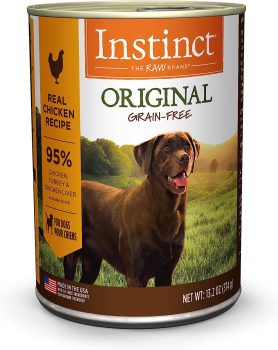Pugs, with their unique and charming personalities, have won the hearts of dog lovers worldwide. However, these adorable canines have specific dietary needs due to their size, activity level, and potential health issues. This comprehensive guide will explore the ideal diet for pugs, focusing on their nutritional requirements to maintain optimal health and vitality.
Understanding Pug’s Nutritional Needs
Pugs require a balanced diet that includes proteins, fats, carbohydrates, vitamins, and minerals. Their diet should cater to their specific needs as a small breed with a moderate activity level. Protein supports muscle maintenance, fats provide energy and support skin health, carbohydrates offer additional energy, and fiber aids in digestion.
Our 5 Top Foods for Pugs
The diets were selected by our founder Justin Palmer, a certified canine nutrition expert, specifically with pugs in mind:
| Food | Pros | Cons |
|---|---|---|
|
|
|
|

Check Today's Price on: |
|
|

Check Today's Price on: |
|
|

Check Today's Price on: |
|
|

Check Today's Price on: |
|
|
High-Quality Protein Sources for Pugs
Protein is a crucial component of a pug’s diet. It should come from high-quality sources like chicken, turkey, lamb, and fish. These proteins support muscle health and overall body maintenance. For pugs with allergies, novel proteins like duck or venison can be considered.
The Role of Fats in a Pug’s Diet
Fats, particularly omega-3 and omega-6 fatty acids, are essential in a pug’s diet. They contribute to a shiny coat and healthy skin. Sources like fish oil and flaxseed can be beneficial. However, it’s important to balance fat intake as pugs are prone to obesity.
Importance of Carbohydrates and Fiber
Carbohydrates provide pugs with energy and should be sourced from whole grains, fruits, and vegetables. These foods also provide essential fiber, promoting good digestive health. Avoid excessive carbohydrate intake to prevent weight gain.
Vitamins and Minerals: Key to Pug Health
A balanced diet for pugs must include essential vitamins and minerals. These support various body functions, including bone health, immune system strength, and metabolic processes. Commercial dog foods typically include these, but supplementation can be considered under veterinary advice.
Hydration: Ensuring Your Pug Drinks Enough Water
Pugs need constant access to fresh, clean water. Proper hydration is crucial for their overall health and helps prevent urinary tract issues and overheating, especially given their brachycephalic nature.
Feeding Schedule and Portion Control for Pugs
Pugs benefit from a structured feeding schedule, typically two meals per day. Portion control is crucial to prevent obesity, a common issue among pugs. The amount of food should be based on their age, size, and activity level.
Dietary Needs of Pug Puppies
Pug puppies have different dietary requirements from adults. They need more calories and specific nutrients to support their growth and development. Puppy-specific formulas are recommended to meet these developmental needs.
Addressing Common Health Issues with Diet
Pugs are prone to health issues like obesity, joint problems, and respiratory issues. A diet that supports joint health and maintains a healthy weight can be beneficial. Foods that are easy to chew and digest are also important due to their brachycephalic facial structure.
Choosing the Right Food: Kibble, Wet, or Raw?
The choice between kibble, wet food, and raw diets depends on the pug’s needs and preferences. High-quality kibble is convenient and can help with dental health, wet food is more palatable and hydrating, and raw diets offer freshness but require careful handling.
Supplements: Beneficial or Not?
While a balanced diet should provide all necessary nutrients, some pugs might benefit from supplements like glucosamine for joint health or omega-3 fatty acids for skin and coat health. Consultation with a vet is essential before adding any supplements.
Human Foods: What’s Safe and What’s Not for Pugs
Some human foods, such as lean meats, certain vegetables, and fruits, are safe for pugs in moderation. However, it’s essential to avoid foods toxic to dogs, such as chocolate, grapes, and onions.
The ideal diet for a pug fulfills their unique nutritional needs and helps prevent common health issues associated with the breed. A balanced mix of proteins, fats, carbohydrates, vitamins, minerals, and plenty of water will contribute to their overall health and well-being. Regular consultation with a veterinarian is crucial to ensure that your pug’s diet continues to meet their evolving needs. Remember, a well-fed pug is a happy, healthy companion for years to come.
What Health Issues Are Pugs Prone To, and How Can a Proper Diet Help?
Pugs are delightful companions, known for their playful and affectionate nature. However, this breed is prone to several health issues, partly due to their distinctive physical features. Understanding these health concerns and how a proper diet can help is essential for every pug owner. This article explores the common health issues in pugs and the role of diet in managing these conditions.
Obesity: A Common Concern in Pugs
Pugs have a tendency to gain weight quickly, making obesity a primary health concern. Excess weight can lead to joint problems, respiratory issues, and a higher risk of diabetes. A diet controlled in calories, coupled with regular exercise, is essential. Feeding measured portions and avoiding excessive treats are critical to managing their weight.
Joint Problems and the Role of Nutrition
Pugs are susceptible to joint issues like hip dysplasia and patellar luxation. A diet rich in omega-3 fatty acids with anti-inflammatory properties can help. Supplements like glucosamine and chondroitin may also support joint health but should be given under veterinary guidance.
Brachycephalic Syndrome and Dietary Considerations
Due to their short noses, pugs often struggle with brachycephalic syndrome, which affects their breathing. A diet that’s easy to chew and swallow can help reduce the risk of respiratory distress during meals. Avoiding foods that cause allergies or excessive mucus production is also beneficial.
Skin Allergies and Nutritional Management
Pugs are prone to skin allergies, which can cause discomfort and irritation. A hypoallergenic diet, or one with limited ingredients, can help identify and avoid allergens. Omega-3 and omega-6 fatty acids can promote healthier skin and a shinier coat.
Eye Health in Pugs: Prevention Through Diet
Pugs are at risk for several eye conditions, including dry eye and corneal ulcers. Antioxidant-rich foods like blueberries, carrots, and leafy greens can support eye health. Proper hydration is also crucial to maintain eye moisture.
The Importance of Dental Health in Pugs
Dental issues are common in pugs due to their tiny mouths. Feeding dry kibble can help reduce plaque and tartar build-up. Dental chews and regular dental check-ups are also essential for maintaining oral health.
Avoiding Gastrointestinal Problems
Pugs can suffer from gastrointestinal issues, including bloating and constipation. A diet with the right balance of fiber can promote digestive health. Smaller, more frequent meals can also help prevent bloating.
Nutritional Needs of Senior Pugs
As pugs age, their nutritional needs change. Older pugs may need a diet lower in calories but higher in fiber and specific supplements to support joint health and cognitive function. Senior-specific dog foods can help meet these changing dietary requirements.
The Risk of Diabetes in Pugs
Pugs are at a higher risk for diabetes, especially if they are overweight. A diet with a low glycemic index, rich in fiber, and controlled in sugars and fats can help manage blood sugar levels and reduce the risk of diabetes.
Heart Health: The Impact of Diet
While heart problems are not as common in pugs as in other breeds, maintaining heart health is essential. Diets low in sodium and rich in omega-3 fatty acids can support heart health. Regular exercise, in addition to a balanced diet, is also crucial.
Conclusion
Understanding the health issues that pugs are prone to and diet’s role in prevention and management is critical to ensuring a long, healthy life for these charming dogs. A balanced diet tailored to their specific needs and regular veterinary check-ups can help mitigate many of the health risks pugs face. Remember, each pug is unique, and their dietary needs may vary, so it’s essential to consult a veterinarian for personalized advice.
Frequently Asked Questions About Feeding Pugs
1. What is the best type of food for a Pug?
The best food for a Pug is a high-quality, balanced diet rich in protein and includes moderate fat and limited carbohydrate content. It should be appropriate for their age, size, and activity level. Look for foods that list real meat as the first ingredient and avoid those with excessive fillers or artificial additives.
2. How much should I feed my Pug each day?
The amount of food a Pug requires depends on age, size, and activity level. Generally, an adult Pug needs about 1 to 1.5 cups of dry dog food daily, divided into two meals. It’s important to adjust this amount based on the Pug’s needs and consult a veterinarian to ensure proper portion sizes.
3. Can Pugs eat grain-free diets?
Grain-free diets can be suitable for Pugs, especially if they have grain allergies or sensitivities. However, ensuring the diet still provides all the necessary nutrients is crucial. Before switching to a grain-free diet, consult a veterinarian to ensure it’s appropriate for your Pug.
4. Is it safe to feed my Pug human food?
Some human foods, such as plain cooked chicken, carrots, and rice, are safe for bugs in moderation. However, many human foods, including chocolate, grapes, onions, and foods containing xylitol, are unsafe for dogs. Always check if a food is safe before sharing it with your Pug.
5. How often should I feed my Pug?
Pugs should ideally be fed twice daily – once in the morning and once in the evening. This helps manage hunger and maintain a consistent energy level throughout the day. It also helps in preventing overeating, which can lead to obesity.
6. Should I add any specific supplements to my Pug’s diet?
Some Pugs may benefit from supplements like omega-3 fatty acids for skin and coat health and glucosamine and chondroitin for joint support. However, accessories should only be added under the guidance of a veterinarian to ensure they are necessary and given in the correct dosage.
7. Can Pugs be put on a vegetarian diet?
Feeding a pug on a vegetarian diet can be challenging as it may not provide all the nutrients they need, particularly protein. Considering a vegetarian diet for your Pug should be done under strict veterinary supervision to ensure they receive a balanced diet.
8. How can I tell if my Pug is overweight?
An overweight Pug might have no visible waistline and no palpable ribs under a layer of fat. Regularly monitoring their body condition and weight and veterinary check-ups can help determine if they are overweight and need dietary adjustments.
9. What should I feed my Pug puppy?
Pug puppies should be fed a high-quality formula specifically designed for small breeds. These formulas are more prosperous in calories and nutrients to support their rapid growth and development. The food should be divided into three to four small meals per day.
10. Can I change my Pug’s diet quickly?
Changing a Pug’s diet should be done gradually over about a week. Start by mixing a small amount of the new food with the old, gradually increasing the fresh food and decreasing the old to avoid gastrointestinal upset.
11. How does diet affect my Pug’s health?
A proper diet is crucial in preventing obesity, maintaining joint health, supporting digestive health, and ensuring a healthy coat and skin in Pugs. A balanced diet can also reduce the risk of chronic diseases like diabetes and heart problems.
12. Should I feed my Pug wet or dry food?
Both wet and dry foods are suitable for Pugs. Dry food can help with dental health and is often more calorie-dense, while wet food can be more palatable and hydrating. Some owners choose to combine both types for variety.
13. What are the signs of food allergies in Pugs?
Signs of food allergies in Pugs include itching, skin rashes, ear infections, and gastrointestinal problems like diarrhea or vomiting. If you suspect your Pug has a food allergy, consult a veterinarian who may recommend an elimination diet to identify the allergen.
14. How do I know if my Pug’s diet is nutritionally balanced?
A nutritionally balanced diet for a Pug should result in a healthy weight, a shiny coat, regular bowel movements, and overall good health. If you have concerns about your Pug’s diet, it’s best to consult with a veterinarian for advice and dietary adjustments.
15. Can Pugs have dairy products?
Some Pugs can tolerate small amounts of dairy products, but many are lactose intolerant. Dairy can cause gastrointestinal upset in these dogs, so avoiding or limiting dairy products is best.
 Check Today's Price on:
Check Today's Price on:
 Toledo, United States.
Toledo, United States.